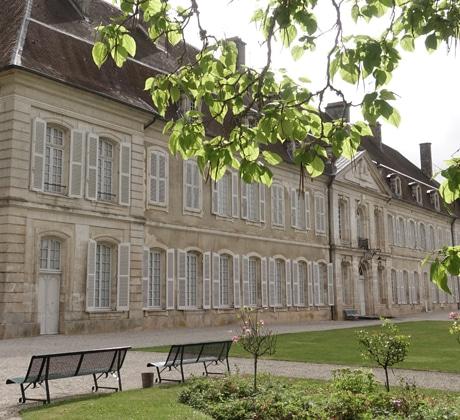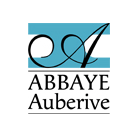Photo Denis Germain
The Cistercian abbey of Alba Ripa, founded in 1135 by 12 monks from Clairvaux abbey, has witnessed great moments in French history. Its destiny has crossed paths with great people of their time.

THE CISTERCIANS
Resulting from the great monastic movement of the 12th century, the presence of St Bernard is to be found within the abbey’s walls.
It has an architectural form typical of the Bernardine layout: a church with a flat-walled chevet facing the east, an east wing used solely by the choir-monks, a west wing for the lay-brothers, and a communal north wing.
Its geographical location is also typical of that preferred by the Cistercians: a remote area of land where the mastery of the surrounding water resource is necessary for the installation and the life of the community. Indeed as the Rule of St Benedict forbade the consumption of meat, the Cistercians developed the rearing of fish.

At Auberive the monks diverted the river Aube for about 1km, creating a system of canals that distributed clean water and disposed of waste water, an additional canal for the mill allowing complete self-sufficiency.
The abbey, 24th daughter-house of the abbey at Clairvaux, reached its peak in terms of possessions in the 13th century with 11 barns, 4 town houses, 14 mills, 13 water ponds and fishponds, an iron mine and a salt mine.
The 14th and 15th centuries are not well documented. It is known that the abbey suffered due to the 100 years war, its herd of 2,540 sheep in 1386 being reduced to 600 by 1418. The abbey was forced to lease out most of its possessions to tenant farmers due to a lack of lay-brothers.
The 16th century marked the beginning of the “commende”. François 1st obtained in 1516, through the Concordat of Bologna, the power to exercise the right of control over abbeys that had belonged to the pope since the end of the 14th century. The king thus chose the “commendataire” abbots, either religious or lay, who earned a part of the abbey’s income.
Auberive did not escape the system and had 14 such abbots between 1519 and 1791. The first, Louis de Rye, had an abbot’s lodging built outside the monastery precinct; its architecture, including its windows, is typical of the first half of the 16th century. The 16th century was also one of religious wars. Auberive was looted twice, in 1567 and 1587, and had great difficulty in collecting its revenues.

RECONSTRUCTION OF THE ABBEY
The 17th and 18th centuries signalled the reconstruction of the abbey buildings. Two periods of construction gave the abbey the appearance it has nowadays. The west and north wings were reconstructed. The 12th century church was demolished (except for the chancel) and was rebuilt in parallel to the east and west wings in a north/south direction.
The west wing became the wing used by guests and was given a chateau-style look with its classical grandiose façade. The bridges over the Aube were also rebuilt, as were the mill’s canal and the dovecot.
Between 1781 and 1787 the east wing was rebuilt according to the plans of the architect Buron and was raised due to problems of dampness.

INDUSTRIAL PERIOD AND PLEASURE RESIDENCE
In 1790 monastic orders were dissolved in France. The 8 monks at the abbey left at the start of 1791 and the estate was sold as a state possession.
Caroillon de Vandeul, son-in-law of the philosopher Diderot, bought the buildings and installed a cotton-weaving business in the east wing between 1797 and 1807. However the business failed and the Vandeul family decided to transform the abbey into a second residence. They notably installed the main entrance gate, designed by the architect Jean Lamour, which came from the abbey at Beaulieu.
After the death of his parents, the son of the Vandeuls sold the abbey to the master foundryman Bordet. Bordet dismantled the 18th century church in order to use the stone to construct a blast furnace 6km away at “la Tuillière”. He enlarged the mill to use it as a orangery.

PRISON PERIOD
In 1856 there began a new period linking the abbey to the old abbey at Clairvaux.
In order to relieve the pressure at the main prison at Clairvaux, the government acquired the abbey at Auberive to house female prisoners. The most well-known of these was the communard Louise Michel, held for 20 months between December 1871 and August 1873 before her deportation to New Caledonia.
The abbey was converted in two stages: the perimeter walls were reinforced, a multi-use chapel was constructed and punishment cells were built in the east wing.
Between 1885 and 1891 the abbey became an industrial teaching establishment for under-age offenders, then from 1894 to 1924 an agricultural teaching establishment for young boys. The boys’ days were split between agricultural work and basic education.

MONASTIC RENEWAL
Between 1925 and 1960, the abbey renewed its links with religion. Monseigneur Ghika founded the St Jean community with the aim of alleviating all distress and supporting all calls to the faith, even those late in life. However due to a lack of funds the buildings were ceded to Benedictine monks from Paris.
Requisitioned during World War II, the abbey was re-occupied afterwards by the Benedictines who restored the chevet and the cloister.
In 1960 the abbey was sold to the Solvay company and was used as a holiday camp for its employees’ children until 2004.
CULTURAL ADVENTURE
In the summer of 2005, the new owners, Volot family, opened the abbey to the public for the first time in its history. Today, the abbey has become a cultural center with many summer activities:
- historical visits
- contemporary art center: exhibition
- concerts, …: program

